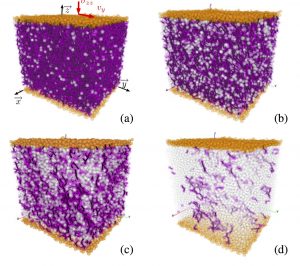Emilien Azéma, Farhang Radjaï, PRL 112, 078001 (2014)

invioletforI∼10−3 (a),I∼0.1(b),I∼0.21(c)andI∼0.6(d). Black lines represent the connection between particles
We analyze inertial granular flows and show that, for all values of the inertial number I, the effective friction coefficient μ arises from three different parameters pertaining to the contact network and force transmission: (1) contact anisotropy, (2) force chain anisotropy, and (3) friction mobilization. Our extensive 3D numerical simulations reveal that μ increases with I mainly due to an increasing contact anisotropy and partially by friction mobilization whereas the anisotropy of force chains declines as a result of the destabilizing effect of particle inertia. The contact network undergoes topological transitions, and beyond I ≃ 0.1 the force chains break into clusters immersed in a background “soup” of floating particles. We show that this transition coincides with the divergence of the size of fluidized zones characterized from the local environments of floating particles and a slower increase of μ with I.